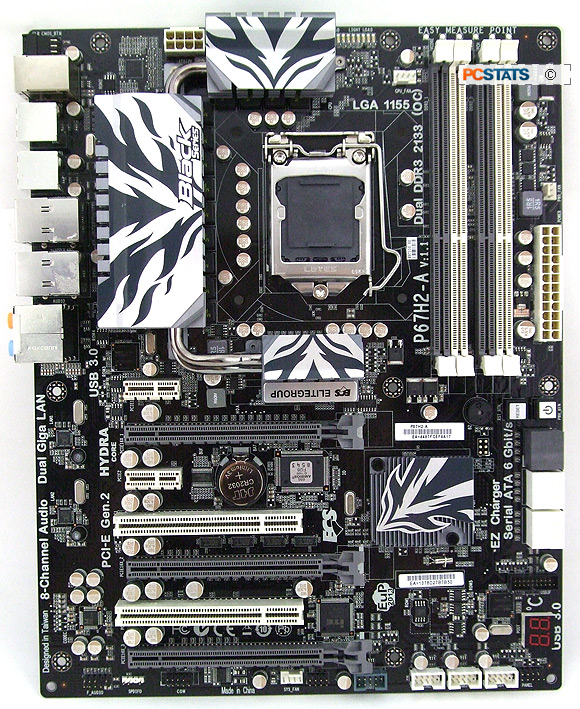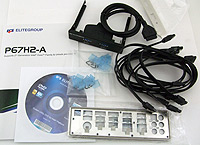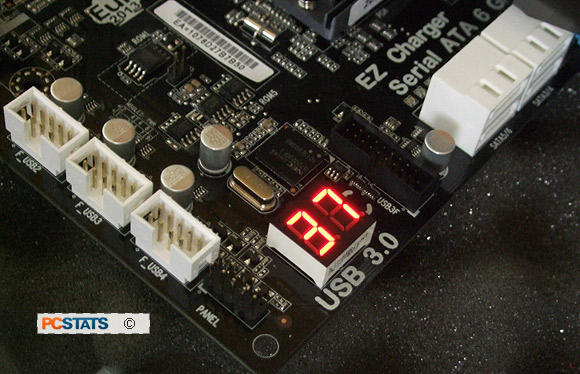One great benefit to building an Intel P67 based computer
is that the P67 platform offers the exact same level of benchmark performance
as an Intel Z68 board with a 'Sandy Bridge' CPU locked in the drivers
seat. However, an Intel P67 board will do this without the
extra costs manufacturers face from slapping on integrated video outputs
most people never use.... in other words, you can get basically the same performance,
for less money, with an Intel P67 board. The two chipsets really only
differ with respect to the Z68's integrated video options and Intel
SRT. If you're looking forward to playing Battlefield 3, ask
yourself what's more important: a few extra bucks to spend on a killer
videocard or integrated graphics options? Uh-huh.
In this article PCSTATS is reviewing the Intel
P67-based ECS P67H2-A Black Extreme motherboard which uses a revised 'B3' stepping Intel
P67 chipset. The ECS
P67H2-A Black Extreme is a performance oriented ATX motherboard with a fantastic set of
gaming and overclocking features, all set on a sleek black and grey PCB that'll
make your expensive chassis proud. ECS has undergone a massive image
improvement in the last couple years and its hardware looks nothing like the
hideous purple boards of yesteryear.
ECS' P67H2-A
Black Extreme motherboard supports 32nm socket LGA1155 2nd Generation Intel Core i3/i5/i7 2xxx-series 'SandyBridge' processors. While the board does not officially support Crossfire/SLI, it can handle
up to 3 videocards running in parallel thanks to an onboard Lucid
HydraLogix 200 'LT24102' chip. Lucid's Hydra Core technology
is
notable because it supports combinations of nVidia and
ATI graphics cards working together. The HydraCore technology has its well known benefits and shortcomings,
depending the graphics cards you choose performance benefits may vary significantly from
game to game. More on Hydra Core technology in a moment.
The ECS P67H2-A Black Extreme motherboard has three
PCI Express x16 2.0 slots which operate in x16/x8/x8 or x16/x16 mode depending
on how many videocards are populated.
If you're sticking with a 32-bit version of Windows 7, the P67H2-A
motherboard will accommodate up to 4GB of dual channel
DDR3-1066/1333/1600/1866/2133 memory in its four 1.5v DDR-3 memory slots. Of course with Windows 7
64-bit you can bump that figure up to 16GB of RAM. While most everything you
could possibly need in a computer is already integrated onto the ECS P67H2-A
motherboard, two PCI Express x1 slots and two legacy PCI slots for are primed
and ready for future expansion. The full-size ECS P67H2-A Black Extreme
motherboard is priced around $330 CDN/USD.
 |
|
ECS P67H2-A Black Extreme
Motherboard |
|


|
|
|
|
INCLUDES: User's Manual, Driver
DVD, (6) SATA cables, USB 3.0 2.5" bay/bracket, I/O
Shield. |

|
|
Chipsets: Intel P67 Express (B3
stepping)
CPU Support: Intel Socket
LGA1155
Memory Type: Dual Channel
DDR3
Videocard Support: (3) PCI
Express x16 2.0 - (x16/x16 or x16/x8/x8
mode)
Crossfire/SLI:
No, Lucid Hydra Core technology
Average Price at time of review:
$330
CDN/USD | |
| |
On the storage
front ECS' P67H2-A Black Extreme motherboard dishes out four 3Gb/s
SATA II ports and two 6Gb/s SATA III ports via the Intel P67 chipset (RAID 0/1/5/10). An extra pair of 6Gb/s eSATA III
ports are positioned at the rear I/O for external hard drives. These eSATA ports come care of
a dedicated Marvell SATA controller.

ECS P67H2-A Black Extreme features a Port80 Card
for debugging. Here the Port80 card reports CPU temp.
The ECS P67H2-A Black Extreme has four USB 3.0
ports at the rear I/O and another pair available via a motherboard header (USB
3.0 bracket included!). These USB3.0 ports come care of two NEC D720200
controllers. Six USB 2.0 ports round out the connectivity at the rear I/O along
with a further eight USB 2.0 headers positioned by the boards' PORT80
card. Network connectivity is strong, the P67H2-A has a pair of Gigabit Ethernet
jacks next to the Intel HD Audio 7.1 channel audio ports.
As with most Intel P67 platforms, there is no support
for legacy IDE hard drives or FDD devices. Included in the motherboard box
you'll find a USB3.0 front panel bracket, a pile of SATA cables and oddly enough
a couple packs of USB socket dust covers. No SLI or Crossfire bridge connectors
are included.

